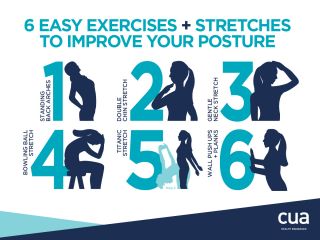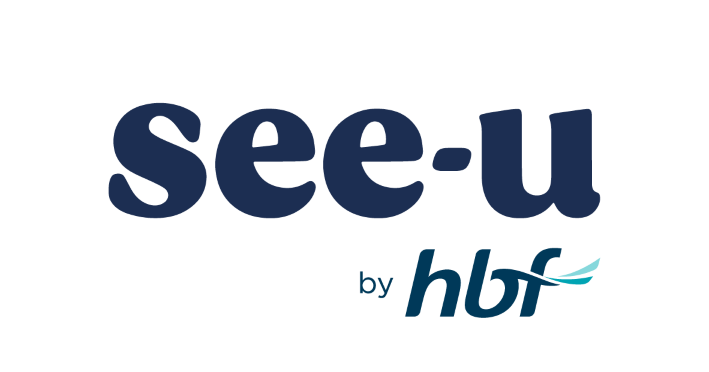Poor posture can cause a raft of health issues that include headaches and muscular aches and pains, according to specialist occupational health and musculoskeletal physiotherapist Cassandra Zaina.
It’s a problem that’s particularly common for people who spend long hours hunched over at a desk.
“Our brain forgets what we’re doing with our body after we’ve been working for about 10 minutes,” Cassandra says.
“Without realising it, we start leaning forward, almost crawling into the computer. Hours later, we’re still in that position. That’s when we start to get headachy and tense in the upper back, and all of a sudden we think, ‘I really don’t feel that good.’”
Cassandra says the inclusion of gentle exercises for good posture into our daily routine helps awaken our subconscious awareness of our body’s position in space.
“We’re too busy focusing on our work to be able to think about our posture all the time, so to make our lives easier we need to help our subconscious brain to automatically find better postures,” she says.
Cassandra has six simple exercises for good posture, which she recommends to her clients.
Good stretches to look and feel great
1. Standing back arches
“This helps to reverse the impact of sustained sitting,” Cassandra says.
“After people do this lovely spine extension they are much more upright, their shoulders are back over their hips and their head is back over their body.” She recommends doing this exercise at least twice a day, if possible.
Instruction:
- Stand up with your feet a little bit wider than your hips and tuck your tailbone slightly under
- Place the heels of your hands on the small of your back
- Gently and slowly arch backwards as far as you can without feeling any discomfort
- Return to a neutral standing position
Repeat 5 times.
2. Double chin stretch
When we’re seated and staring at the computer, we tend to poke our chins forward without realising it, Cassandra says.
This exercise helps correct the head position to return it to a neutral position.
This, in turn, helps reduce the likelihood of headaches and knots in the upper back and neck.
“It’s a good stretch for underneath the skull in the upper neck. If you’ve been craning forward, it will also loosen the lower neck,” Cassandra says.
There are two ways of doing it – with or without the finger pressure.
Instruction:
- Think about keeping your face in a vertical plane and move your head back over your body OR
- Add light over-pressure at the end by placing your fingertips on the front of your chin
Repeat 2-3 times.

3. Gentle neck stretch
“This one is for a muscle that goes from the middle of the neck down to the corner of the shoulder blade (levator scapulae); it’s usually one of the ones that gets really knotty and it can drive a lot of headaches and migraines,” Cassandra says.
She says it’s easy to remember the arm position in this exercise if you think about sniffing your underarm.
Instruction:
- While sitting or standing with your core lightly switched on and your shoulders relaxed, turn your head to the right and look down at your right hip
- Extend the stretch by resting the back of your right hand on the back of your head – over-press slightly to feel a stretch going down the left shoulder blade
- Repeat this exercise on your left side
Repeat 2-3 times on each side.
4. Bowling ball stretch
Weighing in at 4.5-5 kilograms, the human head is almost as heavy as a ten-pin bowling ball.
“It’s not supposed to be hanging out there in front of our body,” Cassandra says.
“When it does, all our muscles - from the back of the head and upper neck that travel down between our shoulder blades - are working really hard to hold the head up so it doesn’t drop down to our chest.”
This exercise is particularly effective for those of us who use a laptop computer as it helps relieve tension at the back of the scalp and in between the shoulder blades.
Instruction:
- While in a seated position, gently rest your chin down on your chest
- Rest one hand on the back of your head so it is like a weight – do not pull your head down
- Slowly slouch in your seat, all the while maintaining the weight of your hand on your head
Repeat 2-3 times.
5. Titanic stretch
It may not be as exciting as the “I’m flying” scene from the movie classic, Titanic, but this stretch for the upper back will leave you feeling energised.
“It really stretches your upper back and lifts your breastbone,” Cassandra says.
Instruction:
- Stand up and take your arms behind you, with your palms facing outwards
- If you do not have shoulder issues, increase the stretch by bringing your hands together behind you, interlacing your fingers and stretching your hands further away
Repeat 2-3 times.
6. Push ups and planks
Instruction:
- A simple version of push ups and planks for strength is to place your palms flat on the wall, with the feet further away hip-width apart, and do wall push ups or planks.
Build up to 3 sets of 10 and gradually move to the floor position (only if you feel comfortable).
Breathe and relax to get the most out of the stretches
Cassandra says it’s important to take nice deep breaths while doing the exercises. “This will help to relax your body and get oxygen to your brain and to the tissues to optimise their wellbeing, as well as reduce stress levels,” she says.
She also recommends that people be mindful of their general fitness levels. “A walk around the block or regular runs, bike rides, swimming and yoga, whatever it might be, is going to help maintain muscular endurance, posture and wellbeing,” Cassandra says.
Cassandra Zaina is a physiotherapy educator and advisor with almost 29 years private practice experience. She is a member of the Australian Physiotherapy Association, the peak body representing 26,000+ physiotherapists and their patients.


